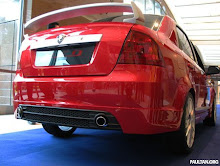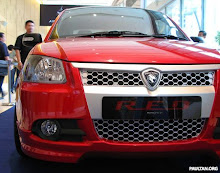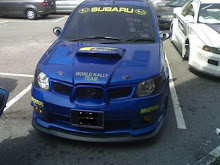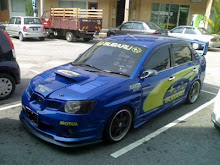
BLM 2008
New Proton Saga BLM teaser promo.
This new proton saga model has open for booking.
This will be little brother for proton persona which will be priced between rm30,000 to rm35,000.


This is probably the most anticipated car in the history that I have had this blog running, the car that will mark the retirement of the old Proton Saga and mark the beginning of a new saga in the history of Proton. It is what both we and Proton call “the People’s Car”.
It is the car that signifies Proton is going back to the basics and fulfilling its responsibility as the national car manufacturer to actually produce national cars that the majority of the people actually need - a cheap, economical run-about car with a sedan bodystyle.
That car is the new second generation 2008 Proton Saga, known to us for the past few months as the Proton BLM.
in the rear seat of the car. You can see clearly the legroom and headroom available to the rear passenger - surprisingly good! The only concern would be the width of the car, it is narrower but acceptable given that this is a small B-segment sedan.
Either 2 adults or 3 children will sit comfortably in the rear bench, and there are seatbelts for 3 people, so if the government enforces the rear seatbelt rule anytime soon, the Proton Saga will
be ready for it.
Interior coneniences include two cupholders in the front, one cupholder in t
he rear, an open storage compartment where the passenger airbag would be expected to be, a glove compartment, two rear bottle holders, door pockets on each door, seatback pockets, a 1-DIN storage area below the 1-DIN CD player, and finally a little compartment just
below the steering wheel column.

The Proton Saga is the first car produced by Malaysian auto manufacturer Proton. Originally based on the 1983 Mitsubishi Lancer Fiore, the Saga first debuted in September 1985 and retained its core Fiore design for two decades, before a successor designed in-house by Proton was launched to replace the ageing platform in 2008.
Since 1985, the Proton Saga and its variants contribute to most of Proton's sales and revenues. The Saga is also the longest surviving model produced by Proton, soldiering on for nearly 22 years.
The Proton Saga was launched in September 1985 by Malaysia's then Prime Minister, Mahathir bin Mohamad. Before the production of Proton Saga, a contest was held to choose the name of the first national car, and the name Saga was chosen from the winner of the contest, Ismail Jaafar,[1], a retired military soldier. When asked why he chose this particular name, he replied as "saga" (Abrus precatorius) is a type of soft, fragile but productive seed commonly found in Malaysia, and that the Proton Saga 1.3 litre engine "is as strong as the saga seed".
The first Proton Saga that rolled off the production line was presented t
o the Malaysian National Museum as a symbol of the beginning of the Malaysian automotive industry. Tun Dr. Mahathir also drove a new Proton Saga with a flag across the Penang Bridge during the opening ceremony of the bridge on 14 September 1985.
Early Saga models were powered by SOHC 8-valve 4-cylinder petrol engines sourced from Mitsubishi, available in both 1.3- and 1.5-litre displacements. Both engines were available with a 5-speed manual transmission, but a 3-speed Mitsubishi Tri-matic automatic was available with the 1.5-liter engine in 1987.
The Saga was originally offered as a 4-door saloon, followed by the addition of a hatchback variant, introduced in 1988 as the Proton Knight and was later know as Saga Aeroback. The Proton Knight was designed for the European market as the hatchback was more popular in United Kingdom.
In 1989, Proton sold the Saga in the United Kingdom with the slogan Jap
anese Technology, Malaysian Style. Since then, United Kingdom contributes most of Proton's export sales. The Saga name was not used and it was simply known as the Proton 1.3 or 1.5. The UK models reverted to the dashboard used in the Mitsubishi Lancer, complete with HVAC controls not found in the domestic model.
In 1990, the line-up was revised with the introduction of 12-valve Megavalve engines, which increased power ratings to 75 bhp (56 kW) (from the original 70.5 bhp (53 kW) in the former 8-valve (Magma) version[2]) for the 1.3-litre engine, and 90 bhp (67 kW) for the 1.5-litre engine. On domestic models, the Saga also gained the "Megavalve" moniker. Minor exterior modifications included a new grill and wraparound black trim pieces. In addition, rear seat belts and a third brake light were fitted as standard.
In 1992, the Saga was given a facelift and its name expanded as Proton Saga Iswara (also known in short as Proton Iswara), after a species of butterfly in Sarawak. Modifications included slimmer headlights, plastic bumpers, side mouldings, coloured door handles, grooved taillight clusters and rear number plate repositioned to the bumper. This particular model is used as taxis in Malaysia and some are converted to NGV. Due to the modification, boot space was reduced by half to accommodate the NGV tank and there are only a few petrol stations by Malaysian oil-giant Petronas in the Klang Valley that sell natural gas, although there are plans underway to increase the number of stations selling it at various locations around Kuala Lumpur.
As a loose successor to the Saga Iswara Sport, Proton gave the Iswara a new facelift and renamed it back to Saga (or know as Saga LMST by local car community) in 2003. The interior has an entirely new dashboard, door panels and an instrument panel with a digital display consisting of an odometer, a fuel gauge and a temperature gauge. Meanwhile, the exterior received new headlights and taillights and colour-coded bumpers and wing mirrors. Proton retuned the 1.3-litre carburettor engine, and fitted a new exhaust system, increasing its power rating to 83 bhp (62 kW). It is only available with the 5-speed manual transmission.
On March 5, 2007, Proton launched the 50th Merdeka Anniversary Promotion in Malaysia, where the announced new price of the Proton Saga at that time was RM26,999. Advertising campaigns for the Saga Aeroback used a notable rendition of Justin Timberlake's hit single SexyBack, with the lyrics changed to "AeroBack". The promotion was made as a support to Malaysia's 50th Merdeka Day and also to thank Proton's customers for their support since Proton Saga was first launched,[3] receiving several minor cosmetic changes. The move was also an attempt by Proton to steal potential sales from Perodua's then-forthcoming budget supermini, the Viva. That year, the Proton Saga became the second best selling car behind Perodua MyVi and the best selling saloon car in Malaysia, with over 15,000 orders.
| Parent company | Proton |
|---|---|
| Also called | Proton Base Line Model (BLM) |
| Production | January 2008[4]-present |
| Class | Subcompact |
| Body style(s) | 4-door saloon |
| Engine(s) | 1.3 L Campro I4 1.6 L Campro I4 |
| Transmission(s) | Aichi Kikai 5-speed manual, Mitsubishi 4-speed automatic[5] |
| Wheelbase | 2,465 mm (97.0 in) |
| Length | 4,257 mm (167.6 in) |
| Width | 1,680 mm (66.1 in) |
| Height | 1,502 mm (59.1 in) |
| Curb weight | 1,060 kg (2,337 lb)-1,085 kg (2,392 lb) |
| Fuel capacity | 40 L (11 US gal; 9 imp gal) |
| Related | Proton Savvy |
On January 18, 2008, Proton unveiled the successor to the 2007 Saga, which was planned to be phased out in June 2008. Retaining the Saga name, the new car is an indigenous design, essentially based on a stretched Proton Savvy platform. The new model is an in-house design developed in collaboration with Korea's LG CNS and Lotus Engineering. This model enables the Malaysian company play to its strength in the home market i.e. the three-box sedan. The Proton Saga is not planned for U.S. launch but will be sold throughout Southeast Asia, in China, India and Australia
As of February 2008, approximately 23,000 customer bookings had been made for the car since its launch and the corresponding waiting time for delivery during that same period stretched up to 5 months.[6]


![saga [kuning gempak]](http://1.bp.blogspot.com/_iMA7fojnf0Y/SmVj0ihnrQI/AAAAAAAAAU8/U4JArkHtPvo/S220/saga+kuning.jpg)



